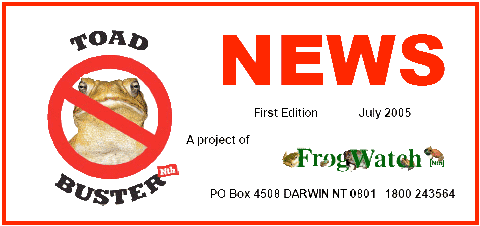
Welcome to the first
ToadBuster News
This
is available in pdf (367 kb)
Editor’s
Note
This
publication is devoted entirely to the efforts now underway to reduce
the impact of the invasive cane toad on our local environment. Everything
we do is aimed at that single outcome – to minimize cane toads
in the Top End of the Northern Territory. We would prefer to talk
about eliminating toads, but we are a practical and realistic group
and accept that, for the time being at least, there is no way to
eliminate them completely. We will have done well if we can prevent
them entering our Top End cities of Darwin and Palmerston and succeed
in saving local wildlife.
We will
certainly attempt to push the toad-front back and, pun intended,
down the track we hope to clean out some areas that the toads have
already colonized. We are optimists, but we are hard headed. We
know that this is a fight that will last many years – perhaps
forever if researchers cannot come up with a total toad solution.
Our task is to hold the line – night after night, month after
month, year after year – until one day perhaps, the final
solution is applied successfully. We won’t sit back and wait
for that. We won’t watch Territory wildlife poisoned and displaced
and do nothing. We believe that most Territorians agree with that
position and we know it will be a community and government effort
to succeed. Our worst enemy is complacency and defeatism –
the view that the fight is pointless, that the toad will ‘settle
into’ the local environment and in a few years time people
won’t notice the difference. People didn’t notice the
difference in Queensland because people grew up with the cane toad.
The damage was done before people knew what they had lost. In the
Territory it is different.
We know
what we stand to lose. Many of the Territory’s unique reptiles
including goannas and frillnecks will suffer localized extinction.
Many other species of bird, mammal, amphibian, even insect life,
are endangered. Perhaps there is nothing that can be done in the
wide open spaces,even in our national parks. But we know that where
there are enough people we can succeed if we have the will to do
it. Join the fight.
Some
things are worth saving!

Congratulations to FrogWatch Coordinator, Ian James Morris,
on the award of the Medal of the Award of Australia (OAM) for services
to environmental education and to the Indigenous communities of
Northern Australia.
The
Cane Toad Forum Kimberley, March 2005
The
community-organised Cane Toad Forum in Kununurra in March was an
eye-opener for Darwin-based FrogWatch (North) representatives for
at least two reasons.
First
was the fact that the Forum was organised and funded mostly by Kimberley
Tourism businesses, determined to do what they can to stop the toad
reaching the Kimberley.
That
stands in stark contrast to the laissez-faire attitude of Territory
tourism ventures, which, with few exceptions, have accepted the
(scientific and governmentsponsored) argument that there is
nothing that can be done in the field to prevent the toad overwhelming
northern Australia.
Second
was the realisation that the Territory now stands alongside Queensland
in Western Australian eyes for ‘doing nothing’ as the
toad scourge swept across the continent.
While
it is true that there has been no organised toad defence in the
Territory until the pest has reached within a few kilometres of
the northern population centres of Darwin and Palmerston, Territorians
are used to pointing the finger at Queensland authorities for ‘doing
nothing’ to halt the spread.
However,
despite the current effort in the western Top End to tackle the
toad through trapping and ‘ToadMusters’, Western Australians
are correct in perceiving that Territory authorities, from the Commonwealth’s
Parks North, which administers Kakadu, to successive Territory Governments
since the toad invasion from the early 1980s, have accepted the
view that there is nothing that can be done in the field and it’s
a waste of money trying.
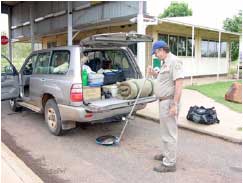
A CALM Ranger checks a traveller’s car for toad ‘hitch-hikers’
at the WA border.
Both
the Commonwealth, Territory and State Governments have put their
faith and money into CSIRO efforts to find a toad cure through introduced
toad-specific disease, genetic manipulation and other laboratory-based
research – so far amounting to spectacularly expensive and
failed attempts in toad-control techniques. Until the beginning
of 2005 no Government had put real money into toad control ‘on
the ground’ meaning that while the scientists evaluated
their research and reported failure, while a few dedicated field
researchers reported local extinctions in the path of the toad (of
northern quolls and sand goannas in particular), the toad itself
was allowed free range to colonise with only the speed it can travel
and climatic conditions imposing limits.
Darwin
and Palmerston together constitute about half of the Territory’s
total population. Other central Territory towns, Alice Springs and
Tennant Creek, are beyond the toad’s climatic range.
Thus,
so far, only the relatively small towns of Borroloola, Nhulunbuy,
Jabiru, Pine Creek and Katherine have had the required human population
density to put up real resistance to the toad’s advance –
and in those places any on-the-ground effort was conducted by individuals
collecting and disposing of toads in their immediate environs.
As Top
FM Radio host, Daryl Manzie, said last year while discussing the
toad invasion, the trouble is that an individual may go out at night
and collect 40 toads and pop them in the freezer, and may go out
and do it again a second and third night, but it isn’t long
before the freezer is full and the individual is disheartened.
While
there are still some individuals in Territory toad-infested areas
doing what they can each night, there is no doubt that organisation
and pooling of community effort will be the only effective way of
putting a spike in the toad’s progress across the
country.
Thus
the Kununurra Forum, the community support it helped engender and
the government inertia that it may have helped end, will be vital
to any success in restricting the range and population size of the
toad in WA.
The
Forum’s call-to-arms was declaration ‘not to wait for
Federal and State Government decisions on what to do to about the
cane toad threat’ and stating: ‘We, the Kununurra community,
have decided to try and come up with strategies that will stop,
or at best slow down and minimise the cane toad impact in the Kimberley’.
The
Forum’s final communiqué called for an increase in
community awareness, education and participation in dealing with
the Cane Toad problem, identification of high risk pathways from
the NT into the Kimberley, and an ‘action plan’ of effective
strategies to ‘stop, or at best delay and minimise the Cane
Toad invasion in the Kimberley’.
Additionally
the Forum called for:
-
The identification of areas of urgent scientific research and
determination of ‘fast track’ methods for actioning
this.
-
The identification of areas of high biodiversity values in the
Kimberley that could be relatively easily protected to keep out
Cane Toads.
-
The listing of the Cane Toad threat to the Kimberley as Threatening
Process under the Environmental Protection and Biodiversity Act.
(A recommendation now adopted by Commonwealth Environment Minister,
Senator Campbell.) and
-
The establishment of Kimberley Cane Toad Website providing an
online discussion forum for public and academic comment.
(See www.canetoads.com.au)
Highlights
(and Lowlights) of the Kimberley Cane Toad Forum.
The
Kakadu escarpment did not act as a barrier to cane toads, as predicted
by some. (A lesson for those who believe the rugged escarpment country
of the Victoria River region, near the Western Australian border,
will be a natural toad barrier.)
- Dave Walden,
Department of Environment and Heritage
Varanus
Panoptes (the yellow spotted or sand goanna) and Merton’s
water monitor have totally disappeared in parts of Arnhemland according
to Aboriginal residents and Kakadu Park rangers.
- Ian Morris,
FrogWatch (North) Coordinator
If
90% of cane toad tadpoles in a waterway are eliminated (through
human intervention) then the remaining 10% will be stronger colonisers
(through reduced competition). Thus the effort must be to get rid
of adult toads.
- Ross Alford
James Cook University Townsville
While
cane toads will dehydrate and die after three days without water,
a toad can rehydrate in slightly moist sand or in cattle dung.
- Ross Alford
James Cook University Townsville
‘Mark
and recapture’ suveys in Townsville show that toad populations
stabilise once they have colonised an area – reports that
numbers ‘decline’ after a few years are due to human
perception and memory fallibilities.
- Ross Alford
James Cook University Townsville
There
has been a 30% decline in freshwater crocodiles (at a site at the
McKinlay River catchment) in 18 months, following cane toad invasion.
-
Adam Britton
Crocodylus Park
“Beautiful
one day, Queensland the next”
One
of Australia's top novelists, Tim Winton, has joined the campaign
to stop cane toads colonising northern Australia.
"It's
a struggle to imagine what it would be like with cane toads,"
he says, "...just massive local extinctions of native animals,
total loss of bush tucker.”
Winton
was a guest at the Kununurra Cane Toad Forum in March, telling the
attendant scientists, professors, environmentalists, business operators
and public servants that there had been ‘a strange fatalism’
among Australia’s leaders on the cane toad – ‘no
sense of political urgency’.
He said
that the lack of scientific knowledge and the consequent lack of
public knowledge meant there was less pressure for government action
and urged the forum to disseminate public information to generate
political will and the ‘sweet and satisfying sound of a few
fingers being pulled out.”

WA
Author, Tim Winton – time off to tackle the toad menace
Winton warns people in southern Western Australia: "Once they
(cane toads) get down into everybody's place at Eagle Bay, and the
Leeuwin Concert and people are spreading their blankets out and
there's toads about them, and people are having the Skyshow and
there's toads on the Perth foreshore, it'll be too late...it could
be beautiful one day, Queensland the next."
Winton
says:” Trapping is the go."
Describing
the one-way-door, cage, field trap developed by FrogWatch in the
Northern Territory Winton points out the traps humane features.
With water provided and the night time light to attract insects
captured toads can even get fatter whilst being kept captive until
collection.
He says
it is time that real money was put into cane toad control.
”For
$1.5million you could get ten teams of people out there in the Victoria
River region of the Northern Territory, working for three months
during that period (September to November) trapping and monitoring."
"You're
getting basically a Maginot Line, if you like, against the toad.
There's
no guarantee it'll work, but it's a damn sight better than what's
been done before, which is nothing."
(From ABC Radio Report)
WA
STATE BUDGET FINDS $900,000 MORE
Western
Australia's ‘war on cane toads’ has been bolstered by
a further $900,000 allocation in the WA State Budget.
Environment
Minister Dr Judy Edwards told the Perth Cane Toad Public Forum that
the new money brought to $1.5million the State Government commitment
to the fight against cane toads since December.
She
said the money showed the State Government's commitment to tackle
the environmental, agricultural and social threats posed by cane
toads – ‘one of the most successful invasive species
the world has seen’.
"WA
is the only State to have actively begun control and monitoring
operations ahead of cane toads invading the State, and we are committed
to keeping them out of WA for as long as possible," she said.
Speakers
at the Forum included author, Tim Winton, FrogWatch coordinator,
Graeme Sawyer, Northern Habitat’s Russell Gueho and Allan
Thompson from Save Endangered East Kimberley Species (SEEKS).
The
minister said that the ‘Cane Toad Initiative’ was focused
on five main components - advance trapping, quarantine and control,
biodiversity asset protection, public awareness and education, and
State-wide co-ordination.
Measures
under the Cane Toad Initiative included:
•
developing and implementing a pre-emptive trapping program in the
Northern Territory, including further trials and development of
trap designs;
•
significantly strengthening quarantine arrangements on the WA/NT
border to capture
hitch-hiking toads;
•
mapping the NT distribution and key dry season refuges that can
be the focus of control efforts;
•
identifying east Kimberley biodiversity hotspot assets at risk from
toads; and
•
producing information material for the broad community to raise
awareness of the looming cane toad menace.
The
funding follows the WA Government allocation of $600,000 for cane
toad management in December, 2004 and the Minister adds that: "We
look forward to the Commonwealth Government honouring its commitment
to match State contributions."
TOAD
SNIFFING DOGS
The
Western Australian Government is exploring thinking of using 'sniffer
dogs' to find toads.
"Dogs
have been used in Queensland to find the introduced red eared slider
turtle that escaped from aquariums and into the wild," WA Environment
Minister Dr Judy Edwards says.
"We
see little reason why dogs could not be trained to track cane toads."
WA
TEAM SURVEYS NT
A five
person cane toad surveillance and control team based in Kununurra
is undertaking surveillance, control and investigation of cane toad
reports in the East Kimberley and Victoria River region of the NT.
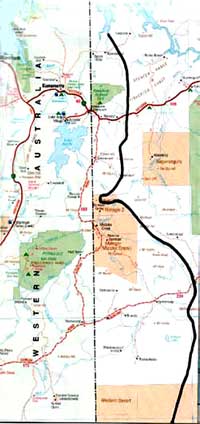
The ‘line in the sand’ – Western Australian
defensive line, east of the NTWA border. Traps and other control
methods are being put in place by CALM.
Areas
monitored for the presence of toads by the team include border cattle
stations in the Territory and settlements such as Kalkarijin and
Amanbji. Most reports of toads to date have been false alarms.
The
surveillance team has so far travelled approximately 25,000km and
identified 120 waterholes, ponds and swamps that have been GPS-marked
and have inspected approximately 55 waterways.
The
surveillance team is working closely with Territory Parks and Wildlife
and FrogWatch (North) to test a range of toad traps and has conducted
trapping trials at Coolibah Station. The traps caught large numbers
of toads.
‘ALBINO’
TADPOLE COULD HELP SCIENTISTS
A white
tadpole that failed to turn into a frog is having its genes examined
at CSIRO Canberra. FrogWatch worker, Dave Wilson, owner manager
of AquaGreen, a water plant, fish and frog business, says the tadpole
was a Litoria Rothi or Roth’s Tree Frog, but failed to metamorphose
on schedule.
“It
was very old for a tadpole and has shown no signs of metamorphosing
after its siblings all hopped away as frogs last December and January.
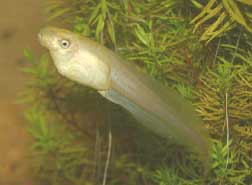
The
white tadpole that failed to develop
With
the assistance of ‘the excellent staff at Berrimah Veterinary
Laboratory’ the tadpole was deep frozen and couriered to CSIRO
Canberra for examination.
Tony
Robinson of CSIRO, Canberra, reported that the tadpole had arrived
safely.
“A
rock solid, large white taddy arrived this morning plus documentation.
We will add it to our collection,” he emailed David.
“Let
us all hope that one day its genetic material may help in the fight
against toads,” says David.
THE
‘GREAT TOP END CANE TOAD ROUND-UP’
Monday
August 1 2005, Darwin Cup Day, has been nominated by FrogWatch (North)
as the night everyone in Darwin, Palmerston and surrounds should
check their backyards, streets, local parks, wetlands and even road
drains for cane toads.
“If
we can get everyone to check their locale on the same night and
report any sightings we could be pretty sure of identifying every
toad colony or individual toad that has reached Darwin and Palmerston
– and take out this pest before it overwhelms us and the native
wildlife,” says FrogWatch coordinator, Graeme Sawyer.
The
date for the ‘Great Top End Toad Round-Up’ has been
chosen because it falls near the middle of the dry season –
meaning that cane toads will be at their most vulnerable.
“It’s
a time of the year when insect life is reduced, toads start getting
hungry and thirsty, when smaller billabongs have dried up and there
is little water lying around to sustain them, a time they will have
either stayed close to waterways or taken up residence in well-watered
gardens.
“Toads
can go about three days without water – thus they must stay
within hopping distance of water or dessicate and die.
“By
the beginning of August any toads in the bush will have either perished
or moved to available
water. That makes them easier to find.”
FrogWatch
(North) hopes to promote the Toad Round-Up through local media –
and is offering cash prizes for the largest toad, the ugliest toad
and the most northerly toad found on the night.
Although
toads have not reached urban areas in numbers recent reported sightings
include an adult female at the corner of Freshwater and Ada Street,
Jingili, a male at Bayview Haven and several toads at a trucking
depot in Berrimah.
“These
may have been ‘hitchhikers’ – but there’s
a good chance that some are the advance guards of the front line
of the toad invasion,” says Graeme.
“The
Round-Up would have the effect of pushing the toad line back –
meaning we can confront the fullon invasion of the next ‘Wet’
knowing that there are no ‘insurgents’ behind our lines.
“Community
effort will be everything in this fight to preserve native wildlife
and lifestyle in the Top End from the toxic toad,” he says.
TRAP
SUBSIDY WELCOMED
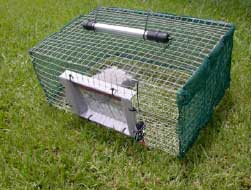
FrogWatch coordinator, Graeme Sawyer believes the $30 subsidy the
Territory Government is offering to people buying cane toad traps
will make a significant difference to the community toad-trapping
effort.
“One
of the hesitations about installing a trap is the cost – it
makes people put the decision off until the next wet. But getting
the traps in place ahead of the toads is a key part of our strategy,”
he says.
“If
people wait until we are overrun with toads before putting traps
in, we’ll be fighting from behind – with every breeding
event multiplying the problem by hundreds of thousands.
“The
initiative is welcome and well targeted at prevention rather than
cure.
“It
continues the community-government partnership in the fight against
the toad and targets a critical issue, that of getting traps into
people’s back yards.
“We’re
working on raising public awareness of the need for people to trap
their own yards and join with neighbours to trap in public areas,
nearby wetlands and their surrounds.
“Cost
is always a factor in people’s commitment and this means that
some 3000 residents will have the financial cost of joining the
fight against the toad reduced – since the funds are capped
it will be on a first-in, first-served basis.
“We
may have to lift production to meet the demand but that’s
good too.”
Traps
are now on sale at NT General Store, Howard Springs Humpty Doo and
Berry Springs Hardware, Hibiscus Pet Shop, and Palmerston Pets.
MARBLED
FROGS ON THE ‘HITLIST’
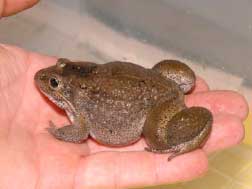
Marbled frogs can be moved from the ‘possible’ to ‘probable’
column in the ever- growing list of species poisoned by eating cane
toads.
A marbled
frog in captive display at the recent Freds Pass Show swallowed
a juvenile toad and died within hours.
FrogWatch
coordinator Graeme Sawyer says the marbled frog and several juvenile
toads had been sharing accommodation for weeks and were regularly
fed “but the show must have made her hungry.”
He says
that the Supervising Scientist’s report on risk assessment
of toads in Kakadu put marbled frogs in the ‘possible’
victims category, alongside green tree frogs. But the death at Freds
Pass suggested the species’ ‘degree of susceptibility’
needed upgrading.
“The
good news is that two frogs that we know can eat toads with some
impunity include some of the Top Ends’ most prevalent species
– the woodlands Giant Frog and wetlands Dahl’s Frog.
“However
this isn’t about what can eat what fastest – it’s
about breeding numbers that overwhelm the local ecology, predating,
competing, and poisoning along the way.”
Tree
frogs are considered less threatened than some other species because
the toad is ground
dwelling and other frogs are not a food staple.
But,
says Sawyer, any frog may scoop up a relatively slow-moving juvenile
toad, particularly if they are thick on the ground – “which
they will be if we don’t act as a community to stop these
toads breeding in Palmerston and Darwin waterways, drains and gardens.”
TOAD INVASION - A LINE IN THE WETLANDS
Top End LandCare and community environment groups are drawing ‘a
line in the wetlands’ against the cane toad to the east of
Darwin and Palmerston, setting up a chain of supertraps in the lower
catchment areas of the Howard, Adelaide and Elizabeth Rivers.
FrogWatch
coordinator, Graeme Sawyer said the chain of supertraps –
which are to be set up at key sites, including Lambells, McMinns,
Giraween, and Knuckey lagoons, in the wetlands of Woodside Reserve
and the Holtze billabongs - were on the ‘eastern front’
of the toad invasion.
Volunteer
organizations to set up, monitor and clear the traps of captured
toads include LandCare, school and residential groups near the lagoons
and wetland sites.
“The
commitment of these volunteer groups is terrific - but it will still
take the participation of hundreds of block owners in rural Darwin
to hold the line.
“We’ve
got Commonwealth Envirofunding to support the supertrap installation
effort – but the key here is to get the traps in before the
toads start to colonise.
That
means putting traps in now – before the next breeding cycle.”
Mr Sawyer
said toad migratory behaviour was for the first arrivals, generally
strong males, to occupy a breeding site then call the females in.
“If
we can trap those first arrivals, we may be able to slow the whole
process – minimise toad numbers and give the wildlife a chance
of survival,” he said.
COMMUNITY
RALLIES
As toads
begin to overrun rural Darwin (Acacia Hills, Darwin River Dam, Litchfield
Park, easterly Humpty Doo, Lambells Lagoon, Fogg Dam) the community
is rallying around efforts to trap, isolate and pinpoint the toad’s
advance.
FrogWatch
now gets up to 50 calls a week from Top Enders reporting toads and
suspect toads, wanting to buy traps and to get information on protecting
pets and wildlife.
As yet
most suspect toads in town turn out to be marbled frogs but the
calls mean that people’s environmental awareness has lifted.
The
toad makes people conscious of the reptiles, frogs and other creatures
that live alongside us – it’s the toad’s only
plus. The big minus is that many of these species may no longer
exist after the toad’s arrival.
In the
rural area unfortunately most toad reports turn out to be toads.
FrogWatch is working with LandCare and other environment groups
to install toad traps at major lagoons and wetlands to the south
and east of Darwin. The plan is to catch the newly arriving adults
before they breed.
But
where breeding has already occurred the immediate strategy through
the ‘dry’ is to wait for the land to dry out, meaning
toads will gather near remaining water sources.
“When
the toads are vulnerable – that is gathered near remaining
water and hungry - then we’ll send in the ‘ToadMuster’
patrols,” says FrogWatch coordinator, Graeme Sawyer.
Interstate
and international interest in the Top End effort to fend off the
toad is growing, evidenced by trap sales into Queensland and northern
NSW, media and internet interest.
FrogWatch
coordinator, Ian Morris, read about local member, David Tollner’s
suggestions that toads should be killed humanely with clubs rather
than freezing while visiting the U.S.A. – an indication of
the level of interest in cane toads, as well as the worldwide interest
in club wielding politicians.
MINING
COMPANIES TO BE ASKED TO JOIN FIGHT
Mining companies across the north of the Territory are to be asked
to join the ‘ToadBusting’ trapping effort and help minimize
cane toads on their mine sites and surrounds.
“Till
now there simply hasn’t been an effective way for mining companies,
or others, to tackle the cane toad invasion,” says
FrogWatch North Coordinator, Graeme Sawyer.
“But
successful field tests of trapping shows the way for these companies.
Near Katherine and at Ringwood and Bonrook Stations traps have caught
large numbers of toads, almost eliminating local toad populations.
“The
cost of the traps is not great (about $1500 for a solar powered
field trap or as low as $150 for smaller traps with cable or battery
power) and we hope that the mining company effort could create local
extinctions of the toxic pest.
“Toads
like disturbed environments such as you find on a mine site and
lighting at night brings them in from the bush. We believe the mining
companies could play a big role in helping to clear toads out of
areas of operation.”
Sawyer
says it is also hoped that mining companies will back the toad control
effort with cash and by sponsoring traps in other locations.
“We
know that some mining companies were actively seeking advice on
cane toad control measures as the pest invaded their sites but,
like everyone else, they discovered there was little information
to guide their efforts.
“That’s
changed now. Trapping is definitely the way to go to reduce, even
eliminate, toads in an area.
Contact
with some key Territory mining companies have shown that the companies
are willing, even keen, to join the effort to reduce toad numbers.
“Some
of these mine sites are located near environments that have, or
will, become ideal toad breeding grounds.
“Joining
the toad control effort also wins companies environmental credits,”
Sawyer says.
|
































